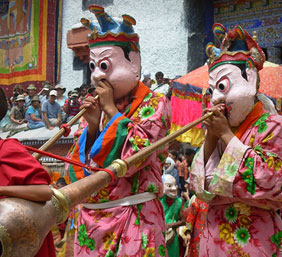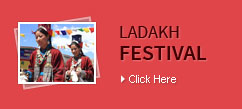
The best way to feel the Ladakhi culture is to witness its vibrant festivals.They are celebrated as an occasion to demonstrate the cultural heritage as well as the wealth of that particular monastery. It is also a merry-making occasion which provides people with various oppurtunities to interact with each other , form new ties and renew the old ones.
Festivals are celebrated on fixed time periods, many of which takes place in winter- a relatively idle time for the majority of the people. The core event of the manastic festival is Chams( a highly choreographed sacred dance-drama) performed by monks, to the accompaniment of mystic tunes played on Monastic orchestra.Lamas robed in colorful garments and wearing masks perform mimics representing various aspect of religion.The masks worn by dacers represent the Guardians ,Protectors and the Gods and Goddesses. huge crowd gather to highten the sense of the ocassion.
Most of the festivals are annnual monastic festivals.Among non monastic festivals are Losar(New Year) festival and the notable Ladakh festival organised by the Jammu and Kashmir Government.
Enjoy the energy,procession,performances,colorful costumes,music ,dancing and art of the festivals.Get deeper into the soul of Ladakh.
Name of Festival |
Venue |
2015 |
2016 |
2017 |
| Spituk Gustor | Spituk | January 18-19 | January 7-8 | January 25-26 |
| Dosmochey | Leh & Likir Monastery | February 17-18 | February 6-7 | February 24-25 |
| Yargon Tungshak | Nubra (Yarma) | February 22-23 | February 12-13 | March 2-3 |
| Stok Guru Tsechu | Stok Monastery | February 27-28 | February 16-17 | March 6-7 |
| Matho Nagrang | Matho Monastery | March 4-5 | February 21-22 | March 11-12 |
| Saka Dawa | All over Ladakh | June 2 | May 20 | June 9 |
| Yuru Kabgyat | Lamayuru Monastery | June 14-15 | July 1-2 | June 21-22 |
| Hemis Tsechu | Hemis Monastery | June 26-27 | July 14-15 | July 3-4 |
| Stongday Gustor | Zanskar | July 4-5 | July 22-23 | July 12-13 |
| Karsha Gustor | Zanskar | July 14-15 | July 31-Aug 01 | July 21-22 |
| Phyang Tsesdup | Phyang Monastery | July 14-15 | July 31-Aug 01 | July 21-22 |
| Sachukul Gustor | Sachukul Monastery | July 4-5 | July 21-22 | July 11-12 |
| Korzok Gustor | Tsomoriri | July 19-20 | August 5-6 | July 26-27 |
| Dakthok Tseschu | Dak thok Monastery | July 26-27 | August 13-14 | August 2-3 |
| Sani Nasjal | Zanskar | July 30-31 | August 17-18 | August 6-7 |
| Deskit Gustor | Nubra | October 10-11 | October 28-19 | October 17-18 |
| Thiksay Gustor | Thiksay | October 30-31 | November 17-18 | November 6-7 |
| Chemday Wangchok / Padum | Chemray Monastery | November 9-10 | November 27-28 | November 16-17 |
| Galden Namchot | All over Ladakh | December 5 | December 23 | December 12 |
| Ladakhi Losar | All over Ladakh | December 12 | December 30 | December 19 |
MONASTIC FESTIVALS IN LADAKH
Hemis Tsechu
The festival of Padmasambhava - The 10th day (Tses- Chu) of the Tibetan lunar month is celebrated as the birthday of Padmasambhava (Guru Rimpoche), the founder of Tibetan Buddhism. The local people are seen dressed up in their finest traditional garb for the occasion. Lamas called 'chhams' perform splendid masked dances and sacred plays to the accompaniment of cymbals, drums and long horns.
The Hemis Monastery celebrates this event in the form of a 2 day festival. Its resident Lamas perform sacred masked dances leading to the destruction of the sacrificial offerings. Masks worn by the Lamas represent various guardian divinities of the Dugpa order, of which Hemis is the leading establishment in Ladakh.
This 200 year-old tradition was introduced by a member of Ladakh's ruling family who was reincarnated in the 18th century as the monastery's Head Lama, 'Sras Rimpoche'. The Hemis dances are a re-enactment of the magical feats of Padmasambhava, in his services to the cause of Buddhism in his eight different manifestations.
The festival takes an auspicious turn every 12 years in the Tibetan Year of the Monkey, when the two-storey high 'Thankga' depicting Padmasambhava is displayed.
As the Hemis festival is held during the peak summer season. It attracts the largest number of people from within and outside Ladakh.
Shachukul Gustor
In Ladakh, most of the festivals are held generally based on the monasteries and Gompas. Shachukul monastery is one such monastery in Ladakh, which is located at an altitude of 14, 000 feet. The Shachukul Gustor is centered on this monastery.
The literal meaning of Gustor is "sacrifice of the 29th day". The festival is marked by a unique dance performance that attracts tourists from all over. This dance shows the victory of black hat dancers over evil. The followers of Tibetan Buddhism take a part in this festival.
The victory over the evil is the main focus of this festival. The festival is celebrated for two days and it ends with the dispersal of the sacrificial cake which is called storma. The leader of the dancers is allowed to do it. This process is called Argham (killing), which represents the destruction of all kinds of evils.
The black hat dancers adorn themselves in different masks to symbolize the patron divinities of the Geluk-pa order and other Buddhist divinities. The dancers also portray the killing of the Tibetan traitor Lang-dar-ma by a Buddhist monk in ninth century.
Karsha Gustor
At the Zanskar (Karsha Gustor) it is the layman who predicts the future instead of reputed soothsayers, who are commonly recognized for this job. The layman is spiritually cleansed by the Lamas after a formal selection, and is prepared for receiving the spirit of the Holy Deity.
During the festival, a Black Hat Dance is performed. The significance of this dance is to ward off the evil forces and to establish the victory of good over the evil. This is also a masked dance, much like Chhams.
The festival culminates with the dismemberment of the sacrificial cake. This is also known as the Storma. The concluding part of the Black Hat Dance during the festival is killing of the evil force by the leader of the dancers, which is known as Argham.
The main feature of this dance is the re-enactment of the assassination of the Tibetan renegade, King Lang-dar-ma, by a Buddhist Monk. The king was said to be a traitor who lived in mid 9th century, and caused a lot of harm to the state. Effigy of the evil forces is burnt at the end of the festival.
Phyang Tsedup
Phyang is one of the two ancient Monasteries in Dringungpa at Ladakh. Here the Phyang Tsedup Festival is held during July-August. During the festival men throng in the Monastery dressed in colorful costumes and also wearing a beautiful smile on their faces.
All these seem to brighten up the mood of the carnival and thus the sacred ceremony Phyang Tsedup is celebrated with enthusiasm and vigor. The founder of the Drigungpa Monastic Dynasty also known as Skyabje Jigten Gombo was regarded as the saintly person. In his memory a Thankha has been erected which is the present site of the famous Phyang Tsedup Festival at Phyang.
The Tibetan skill associated with the construction of Thankha came into action from the time of Dalai Lama V. The Thankha artifacts are renowned throughout the world and have been internationally accredited.
The festival of Phyang Tsedup is celebrated with great deal of pomp and gaiety. It is actually a Buddhist ceremony. The Buddhist Lamas participate in the dance drama known as Chhams.
This dance drama forms the core ceremony of the Phyang Tsedup festival, apart from the worship of the Thankha of Jigten Gombo. The Buddhist Lamas dress up in colorful costumes and play the various characters of the dance drama.
But the most interesting part of the dance drama is the mask. The Lamas perform the dance drama wearing masks. An exhibition is also held during the two day festival of the Phyang Tsedup.
During this festival numerous Buddhist articles are being displayed in order to spread the message of Lord Buddha to the people.
Korzok Gustor
The Korzok Gustor (Tsomoriri Lake) is an ancient festival of the Buddhists. Held in the Korzok Monastery in Ladakh, the Korzok Gustor (Tsomoriri Lake) Festival is famous for its Black Hat Dance. The Korzok Monastery belongs to the Yellow Sect and it is situated in Korzok Village which is located around the splendid Tsomoriri Lake. It is also known as Mountain Lake.
Gustor symbolizes sacrifice. The literal meaning is sacrifice of the 29th day. Belonging to the ancient Geluk-pa order, the Gustor ceremony continues for 2 days. It culminates in sacrificial Storma (it is the forfeited cake) being dismembered by the head of the Black Hat Dancers. This process is also known as Argham.
The cake is then dispersed and this phenomenon is integrally linked to the traditional act of eliminating the evil forces of nature. The enactment of the assassination of the traitor king by a Monk (Padmasambhava) forms an integral part of the Korzok Gustor Ceremony. It is the second incarnation of Buddha.
The Gustor Festival is also held in such places like Spituk, Karsha and Thiksey Monasteries. The Korzak Monastery celebrates Korzak Gustor with tremendous zeal and enthusiasm. The unique location of the Tsomoriri Lake makes it more charming and enticing.
The location of the Tsomoriri Lake is distinctive because it lies in the elevated valley of Rupshu, which is surrounded by 6000 meters high peaks. Tiny speckled population of the Changpas, who are still nomadic, inhabit this place. They are usually shepherds and their main engagement is the work on the caravans. The area is very rich in Kyang or red ass, red fox and mare.
Beside this Mountain Lake, the Monastery of Korzok Gustor is the venue for the performance of the Korzok Gustor Festival. It consists of Black Hat Dance, a masked Dance performed to ward off evil forces from nature. The dancers display guardian divinities.
This ritual dance dates back to few centuries ago when the first Buddhist scriptures came into existence. Usually an effigy is burnt at the end of the festival to signify final destruction of the evil forces.
Takthok Tsechu
Tak-Thok Tse-Chu is an important festival which is held in the month of July and August and draws a large number of tourists and mostly the local people. Observed according to the Buddhist calendar these Tsechu Festivals are a celebration of the Padma Sambhava's exploits. The Buddhists observe a number of Tsechu festivals and they are mostly dedicated to Guru Rimpoche or Padma Sambhava who is considered to be the founder of Tibetan Buddhism. The Tsechu Festivals in Ladakh highlights the enlightening works of Guru Rimpoche's life. Celebrated according to the Buddhist calendar it is generally celebrated on the 10th day of the Lunar Tibetan Calendar.
The word Dak Thok means "Black Rock" in Ladakhi. It is a cave chapel which is a part of the Dak Thok monastery. The members of this Buddhist sect are followers of Padma Sambhava or Guru Rimpoche and the Tsechu Festival celebrates Guru Rimpoche's deeds. The Tsechu Festivals are celebrated by chham dances where both the monks and the local people dance. The dances depict different aspects of the wrathful and compassionate deities and a variety of animals.
This festival is one of the most interesting attractions in Ladakh. The spectators who are watching it bestows merit on them and instructs them in the teachings and even protects them from the evil things. Tsechu is also treated as a social gathering where the local people adorn themselves in the best of clothes and jewelry.
Sani Nasjal
Of the numerous Monastic Fairs and Festivals in Ladakh, the Sant Naro Nasjal (Zanskar) holds special attraction because of the colorfully attired Lamas who perform the ceremony with a lot of enthusiasm. The Sant Naro Nasjal is widely celebrated by the Monks of the Sant Naro Nasjal Monastery.
They celebrate this festival with an incredible amount of zeal and enthusiasm. The Lamas of the Sant Naro Nasjal Monastery perform the Black Hat Dance which symbolically stands forwarding up the evil forces of nature. The lamas of the Sant Naro Nasjal (Zanskar) Monastery dress up in colorful attires and perform the Black Hat Dance. There are numerous stories that are integrally linked to the Black Hat Dance.
Numerous ancient Monasteries have become the identity of the Zanskar Region and Sant Naro Nasjal is one of them. Held in July or August Sant Naro Nasjal festival of the Lamas is accompanied by the performances by the Monks of the Sant Naro Nasjal Monastery.
The Black hat Dance performed by the monks is especially interesting because it consists of the evil and good forces in constant struggle with each other. The evil force is symbolized by Yama and the good force is the (second incarnation of Lord Buddha) known as Padmasambhava. Zanskar is an unforgettable experience for the trekker because it is replete with all the trekking arrangements.
The landscape of the Zanskar region holds special attraction for people because of its exclusive terrain. The valleys of the Zanskar region are vast and filled with grassland. With scattered population the Zanskar region stands amidst vast natural glory. Abundant water supply makes life easy for both people and the livestock.
Thiksay Gustor
The Thiksay Gustor is a two day festival that takes place in Ladakh. It is one of the many variable monastic festivals that take place in Ladakh. The word ‘Gustor’ means literally ‘sacrifice of the 29th date. The Thiksey Gustor festival takes place at the different monasteries of Spituk, Thiksey and Karsha Zanskar.
After the two day celebrations of the Thiksey Gustor, there is a ritualistic dispersal of the Torma or the sacrificial cake. This is done by the leader of the Black Hat dancers and marks the end of the Thiksey Gustor. By the virtue of this act, there is supposedly the destruction of all forms of evils. The assassination of the Tibetan apostate King Lang Darma by a Budhist monk in the mid 9th century is enacted during the festival of Thiksey Gustor. During the Thiksey Gustor in some of the monasteries, there is an effigy symbolizing the stronger evil forces which is burnt. During this festival, there are early morning prayers, which bring divine peace to the minds of those who take part in it.
Chemrey Angchok
On the 28th and 29th day of the 9th month of the Tibetan calendar the Chemrey Angchok is celebrated. The dances of this annual festival draw tourists from all over. Founded in the year 1664 the Chemrey monastery celebrates this festival annually. The festival is marked by a unique dance performance in which, the dancers portray the victory of good over evil and also the lives and stories of other Buddhist and Tibetan divinities.
Galdan Namchot
Galdan Namchot is mainly celebrated to commemorate the birthday and the Buddhahood of the Tibetan saint-scholar, Tsongkhapa. Tsongkhapa was the founder of the Gelukpa School that preached Tibetan Buddhism during the 14th century. In the later years, this Gelukpa School emerged as a major and dominant monastic order in the central Tibet region.
Galdan Namchat Festival is celebrated with a grand fervor by the people in Ladakh. All the monasteries as well as other public and residential buildings are lit up to present a beautiful sight across Ladakh. The Galdan Namchot marks the beginning of the New Year celebrations in Ladakh and continues till the Dosmoche festival. A custom of the Galdan Namchot Festival is the preparation of all kinds of traditional dishes such as the thukpa. People visit friends and families and hold feasts together. There is festive spirit in the air.
LOSAR
Losar celebration in Ladakh can be regarded as the most elaborate and convoluted of the different social and religious events and festivals of Ladakh. There is an interesting story that is at the root of the Losar celebrations in Ladakh. King Jamyang Namgyal , on the eve of setting out on an expedition against the Balistan forces in winter was advised not to lead an expedition before the next year. To solve the problem, keeping the regard of the advice, he preponed the New Year celebrations in Ladakh by two months. This became established as a tradition and since then the Losar is celebrated on the first day of the eleventh month of every year.
Each and everybody - men, women and children make an active participation during the Losar celebrations in Ladakh. The rites and the rituals that are followed during the Losar is an interesting amalgamation of the Buddhist and the pre Buddhist Born religious practices. It is during the end of the harvesting season that people start making preparations for celebrating Losar. Chang, a local barley beer is a popular drink for the Losar celebrations and grain from the harvest is kept for its brewing, as a part of preparations for the Losar celebrations. People wear new clothes and adorn themselves in new jewellery to enhance the festive mood in the air. It is on the 29th day of the 10th month which is the time for the Losar celebrations. The festival starts on the first day of the 11th month officially.





